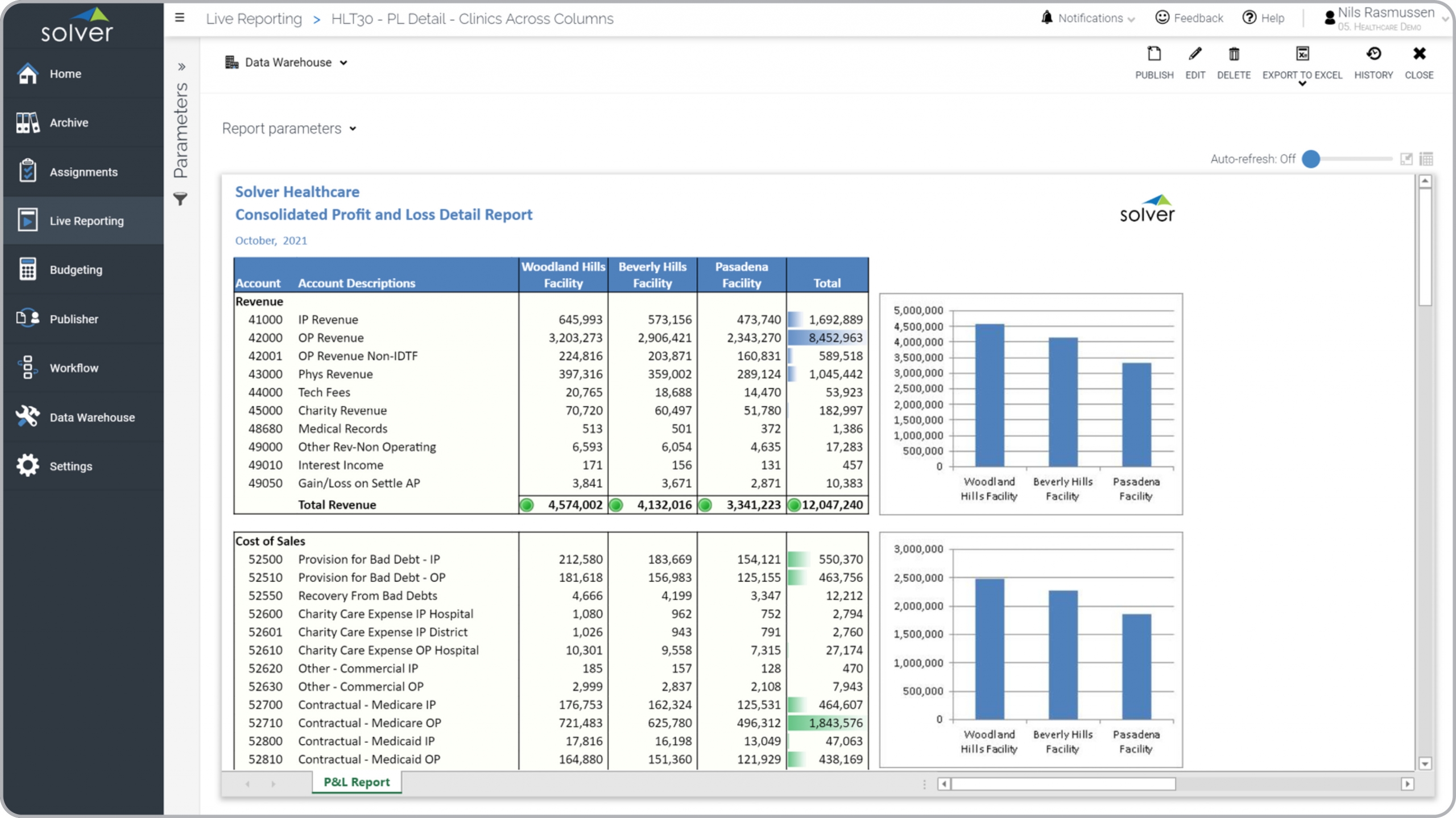Consolidated Profit & Loss Report for a Healthcare Provider
What is
a
Consolidated Profit & Loss Report
? Consolidated profit & loss (P&L) reports are considered essential monthly reports for healthcare groups and are used by Boards, CFOs and Controllers to review monthly aggregate results. Some of the main functionality in this type of financial report is that it is parameter driven and the user can run it for divisions as well as the top consolidated level in the organization. The individual clinics/locations will dynamically expand across the columns with a consolidated total on the far right. The rows are organized in a typical P&L layout, showing revenues, expenses, margins and net profit (loss). You find an example of this type of financial report below.
 Purpose of
Consolidated Profit & Loss Reports Healthcare providers use Consolidated Profit & Loss Reports to provide healthcare executives at the group level with a clear view of consolidated results while at the same time seeing how each clinic individually is contributing. When used as part of good business practices in a Financial Planning & Analysis (FP&A) department, an organization can improve its profitability and financial performance communication as well as reduce the chances that executives make slower or sub-optimal decisions because they don't easily see each location's contribution to consolidated results.
Consolidated Profit & Loss Report
Example Here is an example of a Consolidated Profit & Loss Report for a healthcare provider group and it's clinics. [caption id="" align="alignnone" width="2560"]
Purpose of
Consolidated Profit & Loss Reports Healthcare providers use Consolidated Profit & Loss Reports to provide healthcare executives at the group level with a clear view of consolidated results while at the same time seeing how each clinic individually is contributing. When used as part of good business practices in a Financial Planning & Analysis (FP&A) department, an organization can improve its profitability and financial performance communication as well as reduce the chances that executives make slower or sub-optimal decisions because they don't easily see each location's contribution to consolidated results.
Consolidated Profit & Loss Report
Example Here is an example of a Consolidated Profit & Loss Report for a healthcare provider group and it's clinics. [caption id="" align="alignnone" width="2560"]
 Consolidated Profit & Loss Report for a Healthcare Provider[/caption] You can find hundreds of additional examples
here
Who Uses This Type of
Financial report
? The typical users of this type of financial report are: Boards, CFOs, group controllers.
Other
Financial Report
s Often Used in Conjunction with
Consolidated Profit & Loss Reports Progressive Financial Planning & Analysis (FP&A) departments sometimes use several different Consolidated Profit & Loss Reports, along with KPI and financial dashboards, variance and trend reports, balance sheets, cash flow statements and other management and control tools.
Consolidated Profit & Loss Report for a Healthcare Provider[/caption] You can find hundreds of additional examples
here
Who Uses This Type of
Financial report
? The typical users of this type of financial report are: Boards, CFOs, group controllers.
Other
Financial Report
s Often Used in Conjunction with
Consolidated Profit & Loss Reports Progressive Financial Planning & Analysis (FP&A) departments sometimes use several different Consolidated Profit & Loss Reports, along with KPI and financial dashboards, variance and trend reports, balance sheets, cash flow statements and other management and control tools.
 Where Does the Data for Analysis Originate From? The Actual (historical transactions) data comes from enterprise resource planning (ERP) systems like: Microsoft Dynamics 365 (D365) Finance, Microsoft Dynamics 365 Business Central (D365 BC), Microsoft Dynamics AX, Microsoft Dynamics NAV, Microsoft Dynamics GP, Microsoft Dynamics SL, Sage Intacct, Sage 100, Sage 300, Sage 500, Sage X3, SAP Business One, SAP ByDesign, Acumatica, Netsuite and others. In analyses where budgets or forecasts are used, the planning data most often originates from in-house Excel spreadsheet models or from professional corporate performance management (CPM/EPM) solutions.
What Tools are Typically used for Reporting, Planning and Dashboards? Examples of business software used with the data and ERPs mentioned above are:
Where Does the Data for Analysis Originate From? The Actual (historical transactions) data comes from enterprise resource planning (ERP) systems like: Microsoft Dynamics 365 (D365) Finance, Microsoft Dynamics 365 Business Central (D365 BC), Microsoft Dynamics AX, Microsoft Dynamics NAV, Microsoft Dynamics GP, Microsoft Dynamics SL, Sage Intacct, Sage 100, Sage 300, Sage 500, Sage X3, SAP Business One, SAP ByDesign, Acumatica, Netsuite and others. In analyses where budgets or forecasts are used, the planning data most often originates from in-house Excel spreadsheet models or from professional corporate performance management (CPM/EPM) solutions.
What Tools are Typically used for Reporting, Planning and Dashboards? Examples of business software used with the data and ERPs mentioned above are:
- Native ERP report writers and query tools
- Spreadsheets (for example Microsoft Excel)
- Corporate Performance Management (CPM) tools (for example Solver)
- Dashboards (for example Microsoft Power BI and Tableau)
 Corporate Performance Management (CPM) Cloud Solutions and More Examples
Corporate Performance Management (CPM) Cloud Solutions and More Examples
December 19, 2020
TAGS:
Reporting,
Solver,
report writer,
Microsoft,
consolidation,
template,
practice,
Acumatica,
Netsuite,
Finance,
GP,
hospital,
profit & loss,
Business Central,
excel,
ax,
healthcare,
income statement,
forecast,
Budget,
month,
clinic,
Dynamics 365,
Cloud,
Software,
Tableau,
SAP,
example,
best,
Sage,
BC,
P&L,
D365,
NAV,
Intacct,
provider,
CPM,
report,
SL,
Management,
dynamics,
Power BI,
consolidate,
consolidated income statement



